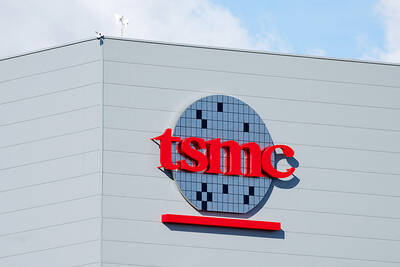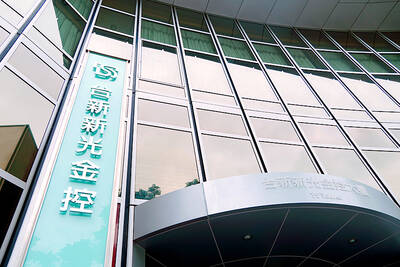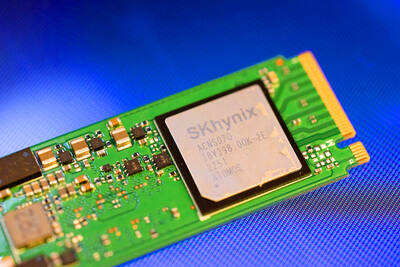In Star Trek: The Motion Picture (1979), a pernicious, high-voltage space fog drifts toward Earth, destroying everything in its path. After several hours of special effects, Captain Kirk discovers that the marauding entity is a living machine called V'Ger. In a shocking twist, its "brain island" -- the tiny seed from which the mass grew -- turns out to be NASA's Voyager 6 space probe, now old and rusty. Over the centuries, the tiny craft has evolved far beyond its creators' imaginations, eventually becoming a technological marvel that subsumed its crude 20th-century kernel.
In short, it's just like Sony's new Clie NR70V organizer.

PHOTO: NY TIMES
Not that this new palmtop is particularly threatening-looking. In fact, it resembles a sleek, silver Star Fleet communicator, complete with flip-open screen. There is no danger of its swallowing Earth, either. At about 5.5 by 3 by 0.7 inches, it slips easily into a pants pocket or purse (although a good inch of it peeks out of a shirt pocket) -- and it does very little marauding.
Like V'Ger, however, the new Sony is an overwhelmingly advanced piece of gear that evolved from an ancient, simple, barely recognizable gadget at its core: the humble Palm organizer.
Like every Palm that has ever walked the earth, the Clie offers a standard suite of programs -- datebook, telephone book, to-do list, calculator -- that synchronize data with a Windows PC, but that is where the similarity ends. The Clie NR70V pushes the envelope so far, it might as well be FedEx.
For example, the Clie is the first Palm-based machine with a built-in keyboard (aside from Handspring's Treo phone). You won't win any typing races on the Clie's tiny, thumb-operated keypad, which is nearly flush with the surrounding surface. Even so, it's often faster and more accurate than using the Graffiti handwriting-recognition alphabet. The NR70V is also the first palmtop with a built-in camera, and it's a blast. A pinhole lens rotates on one section of the hinge; the screen makes a big, bright viewfinder. You can turn the barrel away from you to take a picture of your dinner partner, or toward you to check for spinach in your teeth. A button on the side captures the shot.
At only 320 pixels square, the resulting photos aren't exactly poster-size.
Photos taken by a mere two-megapixel digital camera are 1,600 by 1,200 pixels. Even so, the little snapshots are ideal for use in e-mail, on Web pages and in the Clie's own address book, which provides a place on each "card" for a head shot.
Sony broke new ground with the design, too. The basic slab shape of most palmtops lacks room for everything Sony wanted to include -- screen, handwriting area, keyboard, software buttons -- so the company chose a clamshell design. When the magnesium shell is closed, the screen, keyboard and buttons are protected inside. When it's open, the screen is on top and the keyboard is on the bottom, as if it were a Munchkin laptop -- another first for the Palm world.
Riddle of the pivot
The arrangement is fine for thumb typing on the Clie, but when you want to write, your fist winds up hitting the keyboard, inserting random characters into your writing. That, no doubt, is why the screen is mounted on a pivot post. When you want to write, you can twist the screen on its axis, so that it's facing away from you, and then fold it back down over the keyboard, now inside-out. It's a lot like the flip-out screen on a camcorder.
Contemplating this flipped-screen business without seeing it is enough to make your brain hurt. For example, shouldn't the screen now be upside-down? And wouldn't the Graffiti writing area wind up above the screen instead of beneath it?
Yes, on both counts. Fortunately, the Clie's software automatically flips the screen image to compensate, and because the writing area is only an image displayed on the touch screen (instead of a dedicated opaque panel, as on most Palms), it jumps automatically to the proper end of the rectangular screen.
The on-screen Graffiti area affords two additional luxuries: First, as you write, the Clie displays the letter shapes you're forming right there at your stylus tip, as though you're using real ink. You get to see just how closely your lettering resembles the prescribed shapes, which makes you a much better Graffiti artist.
Second, in certain programs, you can hide the writing area altogether, giving you a gigantic, full-length, rectangular screen. Unfortunately, programs must be specially written to capitalize on this feature, and only a few have been. They include the TinySheet 4.1 spreadsheet, available at www.iambic.com, and PhotoStand, a full-screen picture viewer that comes with the Clie.
All those firsts and enhancements -- along with the Clie's 66MHz processor, twice as fast as any previous Palm compatible -- would be enough to earn Sony this year's Palmtop d'Or award, if there were such a thing; but this model also inherits a long list of enhancements that appeared on earlier Clies.
For example, a thumbwheel makes it easy to manipulate lists and menus, a Back button lets you retreat through the last several screens, and an infrared transmitter acts as a remote control for 20 brands of home-entertainment gear. The NR70V even comes with earphones that capitalize on the machine's ability to play MP3 music files. Finally, as on other Clie models, this one's superbright color screen has four times the resolution of standard Palm screens, yielding much sharper pictures and text in most programs.
All charged up
These high-tech goodies have only a small impact on battery life. If you use the machine 30 minutes a day and go easy on the music playing, Sony says, a battery charge will last 10 days. When you're in an outlet-free zone -- on safari, say -- an optional US$40 adapter lets you recharge it with AA batteries.
Unfortunately, there is another groundbreaking aspect of the NR70V. At UD$600, it's the most expensive Palm-based organizer you can buy.
A sister model, the NR70, lacks the camera and saves you US$100.
The Clie is unequivocally the coolest, highest-tech palmtop yet, a living prop from a James Bond movie. Flash this amazing-looking appliance in public, and you're the focus of instant attention. But ouch! US$600! For that money, you could buy two color Palm m130s, or a full-fledged Dell PC. Even Sony admits that at that price, its new flagship organizer isn't for everyone. The question is, Is it for anyone?
For fans of software elegance, it's nice that you can now buy a Palm-based gadget that's as capable (and expensive) as hand-helds from the rival camp, Microsoft's Pocket PC. Multimedia palmtops have their limits, though, and this one is no exception. Yes, the NR70V can play back movies -- provided your flicks are no longer than, say, Star Trek: The Motion Snippet. Yes, it plays MP3 files, but you have to buy a Memory Stick to hold a reasonable number of songs (US$60 for 128MB, enough for about 30 songs).
Yes, the new Clie's surprisingly good speaker can play recorded sound files, not just beeps, like most Palms, but it's silly that there's no microphone for recording voice notes, and despite the NR70V's otherwise futuristic sensibility, no modem of any kind is available for it.
So, no, the new Clie won't be a Walkman-size hit when it arrives in stores next month. Even so, if you have the techno-lust and the cash, you'll find it an endlessly surprising and multifaceted machine. That photo-taking business is especially addictive. In short, Sony is offering you the chance to take home a machine that you might ordinarily encounter only on a table at a trade show, labeled "Future concept."

On Tuesday, US President Donald Trump weighed in on a pressing national issue: The rebranding of a restaurant chain. Last week, Cracker Barrel, a Tennessee company whose nationwide locations lean heavily on a cozy, old-timey aesthetic — “rocking chairs on the porch, a warm fire in the hearth, peg games on the table” — announced it was updating its logo. Uncle Herschel, the man who once appeared next to the letters with a barrel, was gone. It sparked ire on the right, with Donald Trump Jr leading a charge against the rebranding: “WTF is wrong with Cracker Barrel?!” Later, Trump Sr weighed

Taiwan Semiconductor Manufacturing Co (TSMC, 台積電) secured a record 70.2 percent share of the global foundry business in the second quarter, up from 67.6 percent the previous quarter, and continued widening its lead over second-placed Samsung Electronics Co, TrendForce Corp (集邦科技) said on Monday. TSMC posted US$30.24 billion in sales in the April-to-June period, up 18.5 percent from the previous quarter, driven by major smartphone customers entering their ramp-up cycle and robust demand for artificial intelligence chips, laptops and PCs, which boosted wafer shipments and average selling prices, TrendForce said in a report. Samsung’s sales also grew in the second quarter, up

HEADWINDS: Upfront investment is unavoidable in the merger, but cost savings would materialize over time, TS Financial Holding Co president Welch Lin said TS Financial Holding Co (台新新光金控) said it would take about two years before the benefits of its merger with Shin Kong Financial Holding Co (新光金控) become evident, as the group prioritizes the consolidation of its major subsidiaries. “The group’s priority is to complete the consolidation of different subsidiaries,” Welch Lin (林維俊), president of the nation’s fourth-largest financial conglomerate by assets, told reporters during its first earnings briefing since the merger took effect on July 24. The asset management units are scheduled to merge in November, followed by life insurance in January next year and securities operations in April, Lin said. Banking integration,

LOOPHOLES: The move is to end a break that was aiding foreign producers without any similar benefit for US manufacturers, the US Department of Commerce said US President Donald Trump’s administration would make it harder for Samsung Electronics Co and SK Hynix Inc to ship critical equipment to their chipmaking operations in China, dealing a potential blow to the companies’ production in the world’s largest semiconductor market. The US Department of Commerce in a notice published on Friday said that it was revoking waivers for Samsung and SK Hynix to use US technologies in their Chinese operations. The companies had been operating in China under regulations that allow them to import chipmaking equipment without applying for a new license each time. The move would revise what is known